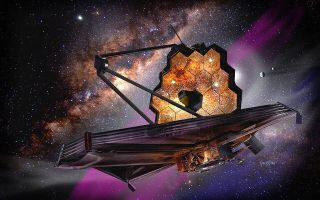
An artist’s illustration of the James Webb Space Telescope.
(Image credit: Alamy)
Something is awry in our expanding cosmos.
Nearly a century ago, the astronomer Edwin Hubble discovered the balloon-like inflation of the universe and the accelerating rush of all galaxies away from each other. Following that expansion backward in time led to our current best understanding of how everything began — the Big Bang.
But over the past decade, an alarming hole has been growing in this picture: Depending on where astronomers look, the rate of the universe’s expansion (a value called the Hubble constant) varies significantly.
Related: ‘It could be profound’: How astronomer Wendy Freedman is trying to fix the universe
Now, on the second anniversary of its launch, the James Webb Space Telescope (JWST) has cemented the discrepancy with stunningly precise new observations that threaten to upend the standard model of cosmology.
The new physics needed to modify or even replace the 40-year-old theory is now a topic of fierce debate.
“It’s a disagreement that has to make us wonder if we really do understand the composition of the universe and the physics of the universe,” Adam Riess, a professor of astronomy at Johns Hopkins University who led the team that made the new JWST measurements, told Live Science. Reiss, Saul Perlmutter and Brian P. Schmidt won the 2011 Nobel Prize in physics for their 1998 discovery of dark energy, the mysterious force behind the universe’s accelerating expansion.
Starting with a bang

An illustration of the expansion of the Universe. The Big Bang is immediately followed by a rapid expansionary period called inflation. Then, as protons and electrons combine to form atoms, light can travel freely; leaving the cosmic microwave background imprinted upon the sky. The universe’s expansion slowed around 10 billion years ago, and it began to fill with galaxies, stars and giant black holes. Around 5 billion years ago, dark energy caused this cosmic expansion to rapidly accelerate. To this day, it shows no signs of stopping. (Image credit: Mark Garlick/Science Photo Library via Getty Images)
On this much cosmologists can agree: It started with a bang.
Then in an instant, the young cosmos was formed: an expanding, roiling plasma broth of matter and antimatter particles that popped into existence, only to annihilate each other upon contact.
Left to their own devices, the matter and antimatter inside this plasma mire should have consumed each other entirely. But scientists believe that some unknown imbalance enabled more matter than antimatter to be produced, saving the universe from immediate self-destruction.
Gravity compressed the plasma pockets, squeezing and heating the matter so that sound waves traveling just over half the speed of light, called baryon acoustic oscillations, rippled across their surface.
Meanwhile, the high energy density of the early universe’s crowded contents stretched space-time, pulling a small fraction of this matter safely from the fray.
As the universe inflated like a balloon, the standard story goes, ordinary matter (which interacts with light) congealed around clumps of invisible dark matter to create the first galaxies, connected together by a vast cosmic web.
Related: James Webb telescope detects the earliest strand in the ‘cosmic web’ ever seen
Initially as the universe’s contents spread out, its energy density and therefore its expansion rate decreased. But then, roughly 5 billion years ago, galaxies began to recede once more at an ever-faster rate.
The cause, according to this picture, was another invisible and mysterious entity known as dark energy.
The simplest and most popular explanation for dark energy is that it is a cosmological constant — an inflationary energy that is the same everywhere and at every moment; woven into the stretching fabric of space-time. Einstein named it lambda in his theory of general relativity.
As our cosmos grew, its overall matter density dropped while the dark energy density remained the same, gradually making the latter the biggest contributor to its overall expansion.
Added together the energy densities of ordinary matter, dark matter, dark energy and energy from light set the upper speed limit of the universe’s expansion. They are also key ingredients in the Lambda cold dark matter (Lambda-CDM) model of cosmology, which maps the growth of the cosmos and predicts its end — with matter eventually spread so thin it experiences a heat death called the Big Freeze.
Many of the model’s predictions have been proven to be highly accurate, but here’s where the problems begin: despite much searching, astronomers have no clue what dark matter or dark energy are.
“Most people agree that the universe’s present composition is 5% ordinary, atomic matter; 25% cold, dark matter; and 70% dark energy,” Ofer Lahav, a professor of astronomy at University College London who is involved in galaxy surveys of dark energy, told Live Science. “The embarrassing fact is, we don’t understand the last two of them.”
But an even greater threat to Lambda-CDM has materialized: Depending on what method astrophysicists use, the universe appears to be growing at different rates — a disparity known as the Hubble tension. And methods that peer into the early universe show it expanding significantly faster than Lambda-CDM predicts. Those methods have been vetted and verified by countless observations.
“So the only reason that I can understand, at this point, for them to disagree is that the model that we have between them is perhaps missing something,” Riess said.
Climbing the cosmic ladder

The cosmic microwave background: The universe’s ‘baby picture’ taken by the European Space Agency’s Planck satellite. (Image credit: European Space Agency)
Measuring the universe’s expansion takes a little bit more than a radar gun.
The first method to measure this growth looks at the so-called cosmic microwave background (CMB), a relic of the universe’s first light produced just 380,000 years after the Big Bang. The imprint can be seen across the entire sky, and it was mapped to find a Hubble constant with less than 1% uncertainty by the European Space Agency’s (ESA) Planck satellite between 2009 and 2013.
In this cosmic “baby picture,” the universe is almost entirely uniform, but hotter and colder patches where matter is more or less dense reveal where baryon acoustic oscillations made it clump. As the universe exploded outward, this soap-bubble structure ballooned into the cosmic web — a network of crisscrossing strands along whose intersections galaxies would be born.
Related: $100,000 Breakthrough physics prize awarded to 3 scientists who study the large scale structure of the universe
By studying these ripples with the Planck satellite, cosmologists inferred the amounts of regular matter and dark matter and a value for the cosmological constant, or dark energy. Plugging these into the Lambda-CDM model spat out a Hubble constant of roughly 46,200 mph per million light-years, or roughly 67 kilometers per second per megaparsec. (A megaparsec is 3.26 million light-years.)
Let’s pause on this number for a moment: if a galaxy is at a distance of one megaparsec away from us, that means it will retreat from us (and us from it) at 67 kilometers per second. At twenty megaparsecs this recession grows to 1,340 kilometers per second, and continues to grow exponentially there onward. If a galaxy is any further than 4,475 megaparsecs away, it will recede from us faster than the speed of light.
A second method to find this expansion rate uses pulsating stars called Cepheid variables — dying stars with helium-gas outer layers that grow and shrink as they absorb and release the star’s radiation, making them periodically flicker like distant signal lamps.
In 1912, astronomer Henrietta Swan Leavitt found that the brighter a Cepheid was, the slower it would flicker, enabling astronomers to measure a star’s absolute brightness, and therefore gauge its distance.
It was a landmark discovery that transformed Cepheids into abundant “standard candles” to measure the universe’s immense scale. By stringing observations of pulsating Cepheids together, astronomers can construct cosmic distance ladders, with each rung taking them a step back into the past.
“It’s one of the most accurate means that astronomers have today for measuring distances,” Wendy Freedman, an astrophysicist at the University of Chicago, told Live Science.
To build a distance ladder, astronomers construct the first rung by choosing nearby Cepheids and cross-checking their distance based on pulsating light to that found by geometry. The next rungs are added using Cepheid readings alone.

RS Puppis, a Cepheid star located 6,000 light-years away in the constellation Puppis and imaged by the Hubble Space Telescope. (Image credit: Alamy)
Then, astronomers look at the distances of the stars and supernovas on each rung and compare how much their light has been redshifted (stretched out to longer, redder wavelengths) as the universe expands.
This gives a precise measurement of the Hubble constant. In 2019, the method was used by Riess and his collaborators, who trained the Hubble Space Telescope on one of the Milky Way’s closest neighbors, the Large Magellanic Cloud.
Their result was explosive: an impossibly high expansion rate of 74 km/s/Mpc when compared to the Planck measurement.
Yet Hubble lacked the necessary precision for the crowded regions of space the team was studying, causing some distant Cepheids to blur into neighboring stars. Dissenting cosmologists had some room left to argue that the result, however shocking, could have come from a measurement error.
Related: Hubble Telescope captures a galaxy’s ‘forbidden’ light in stunning new image
So when JWST launched in December 2021, it was poised to either resolve the discrepancy or cement it. At 21.3 feet (6.5 m) wide, JWST’s mirror is almost three times the size of Hubble’s, which is just 7.9 feet (2.4 m) wide. Not only can JWST detect objects 100 times fainter than Hubble can, but it is also far more sensitive in the infrared spectrum, enabling it to see in a broader range of wavelengths.
By comparing Cepheids measured by JWST in the galaxy NGC 4258 with bright Type Ia supernovas (another standard candle because they all burst at the same absolute luminosity) in remote galaxies, Riess and his colleagues arrived at a nearly identical result: 73 km/s/Mpc.
Other measurements — including one made by Freedman with the Hubble Space telescope on the rapid brightening of the most luminous “tip of the branch” red giant stars, and another with light bent by the gravity of massive galaxies — came back with respective results of 69.6 and 66.6 km/s/Mpc. A separate result using the bending of light also gave a value of 73 km/s/Mpc. Cosmologists were left reeling.
“The CMB temperature is measured at the level of 1% precision, and the Cepheid distance ladder measurement is getting close to 1%,” Ryan Keeley, a cosmologist at the University of California, Merced who has been working to explain the Hubble tension, told Live Science. “So a difference of 7 kilometers per second, even though it’s not very much, is very, very unlikely to be a random chance. There is something definite to explain.”

A collection of some of the most recent measurements of the Hubble constant. From left to right, the sources used to measure its value are: The cosmic microwave background captured by the European Space Agency’s Planck satellite; gravitational lensing and Tip of the Red Giant Branch stars measured by NASA’s Hubble Space Telescope; and Cepheid stars seen by the James Webb Space Telescope. (Image credit: Future)
Cosmology in crisis
Other measurements — including one made by Freedman with the Hubble Space telescope on the rapid brightening of the most luminous “tip of the branch” red giant stars, and another with light bent by the gravity of massive galaxies — came back with respective results of 69.6 and 66.6 km/s/Mpc. A separate result using the bending of light also gave a value of 73 km/s/Mpc. Cosmologists were left reeling.
“The CMB temperature is measured at the level of 1% precision, and the Cepheid distance ladder measurement is getting close to 1%,” Ryan Keeley, a cosmologist at the University of California, Merced who has been working to explain the Hubble tension, told Live Science. “So a difference of 7 kilometers per second, even though it’s not very much, is very, very unlikely to be a random chance. There is something definite to explain.”
The new result leaves the answer wide open, splitting cosmologists into factions chasing staggeringly different solutions. Following the Hubble Space telescope result, an official attempt to resolve the issue at a 2019 conference at the Kavli Institute for Theoretical Physics (KITP) in California only caused more frustration.
“We wouldn’t call it a tension or problem, but rather a crisis,” David Gross, former director of the KITP and a Nobel laureate, said at the conference.
How things can be fixed is unclear. Riess is pursuing a tweak to the Lambda-CDM model that assumes dark energy (the lambda) isn’t constant but instead evolves across the life of the cosmos according to unknown physics.
However Keeley’s research, published Sept. 15 in the journal Physical Review Letters, contradicts this. He and his colleagues found that the expansion rates matched the predictions of Lambda-CDM all the way back to the CMB. So, if the model needs fixing anywhere, it’s most likely in the very early universe, Keeley said.
It could be possible to add some extra dark energy before the emergence of the cosmic microwave background, Keeley said, giving some additional oomph to the universe’s expansion that needn’t make it break from the standard model.
Another group of astronomers is convinced that the tension, alongside the observation that the Milky Way resides inside an underdense supervoid, means that Lambda-CDM and dark matter must be thrown out altogether.
What should replace it, according to Pavel Kroupa, a professor of astrophysics at the University of Bonn, is a theory called Modified Newtonian Dynamics (MOND).
The theory proposes that for gravitational pulls ten trillion times smaller than those felt on Earth’s surface (such as the tugs felt between distant galaxies) Newton’s laws break down and must be replaced by other equations.

The Keenan-Barger-Cowie supervoid. Proponents of the theory of Modified Newtonian Dynamics (MOND) argue that our Milky Way’s presence near the center of the 2-billion-light-year wide underdensity of galaxies is skewing our measurements of the Hubble constant. (Image credit: AG Kroupa/University of Bonn)
Other astronomers say that their own calculations nix the MOND claims, yet Kroupa insists that cosmologists looking to tweak the standard cosmological model are “basically adding additional complications to an already very messy and complicated theory.”
“What I am experiencing and witnessing is an essential breakdown of science,” Kroupa said.
Lahav is agnostic. It’s possible Lambda-CDM just needs a tweak, he said, or maybe dark matter and dark energy are the modern-day equivalent of epicycles, the small circles ancient Greek astronomers used to model planets orbiting Earth. “The orbits of planets were described very accurately by epicycles,” Lahav said. “It was a good model! It fitted the data.”
But once astronomers placed the sun in the center of the solar system in newer models, epicycles eventually became irrelevant, he added.
“If we want to go philosophical, maybe that’s what’s going on,” Lahav said. “But maybe also there is dark matter and dark energy and it’s just not been discovered yet.”
Cosmologists are looking for answers in a number of places. Upcoming CMB experiments, such as the CMB-S4 project at the South Pole and the Simons Observatory in Chile, are searching for clues in ultraprecise measurements of the early universe’s radiation. Others will look to the dark matter maps produced by ESA’s Euclid space telescope or to the future dark energy survey conducted by the Dark Energy Spectroscopic Instrument.
Although it now seems less likely, it’s also still possible the Hubble tension could be resolved by figuring out some unseen systematic flaw in current measurements.
For Freedman, a solution, or possibly further riddles, will come from the JWST. Her team is using the telescope’s powerful eye to make ultradetailed measurements of Cepheid variables; tip-of-the-red-giant-branch stars; and a type of carbon star called JAGB stars all at once distance.
“We’ll see how well they agree and that will give us a sense of an overall systematic answer,” Freedman said.
Freedman has looked only at stars in one galaxy so far but is already seeing a difference from the Hubble space telescope measurements.
“I’m really excited because I think we’re going to have something really interesting to say,” Freedman said. “I’m just completely open. I don’t know where this is going to fall.”
Join our Space Forums to keep talking space on the latest missions, night sky and more! And if you have a news tip, correction or comment, let us know at: [email protected].
Breaking space news, the latest updates on rocket launches, skywatching events and more!
Ben Turner is a U.K. based staff writer at Live Science. He covers physics and astronomy, among other topics like weird animals and climate change. He graduated from University College London with a degree in particle physics before training as a journalist. When he’s not writing, Ben enjoys reading literature, playing the guitar and embarrassing himself with chess.
>>> Read full article>>>
Copyright for syndicated content belongs to the linked Source : Space.com – https://www.space.com/james-webb-space-telescope-cosmology-broken































